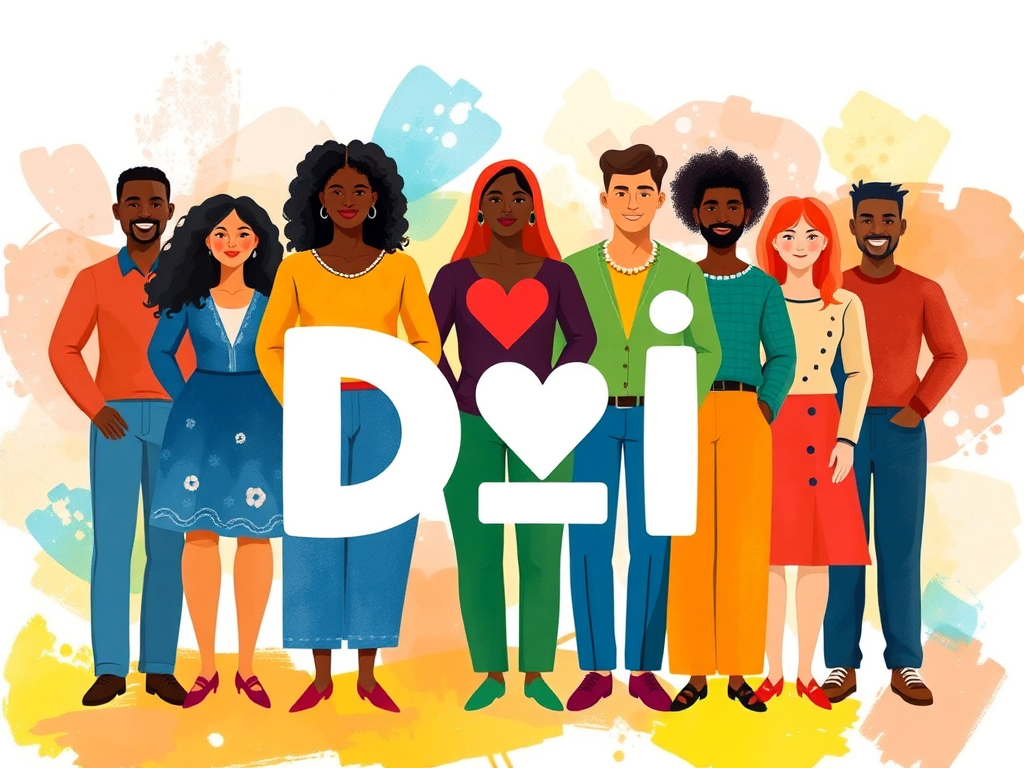In today’s rapidly evolving business landscape, Diversity, Equity, and Inclusion (DEI) has transformed from a mere corporate buzzword into a fundamental business imperative. Organizations worldwide are recognizing that workplace diversity isn’t just about doing what’s morally right—it’s about creating competitive advantage and driving financial performance through inclusive practices.
Understanding DEI: More Than Just Buzzwords
What is DEI and Why It Matters
DEI stands for Diversity, Equity, and Inclusion—three interconnected concepts that form the foundation of modern organizational culture. According to the Society for Human Resource Management (SHRM), 56% of employed U.S. adults believe that focusing on DEI initiatives at work is beneficial, highlighting the growing recognition of its importance.
Diversity represents the presence of differences within a given setting, encompassing various dimensions including:
- Race and ethnicity
- Gender and gender identity
- Age and generational diversity
- Cultural backgrounds
- Physical and mental abilities
- Sexual orientation
- Religious beliefs
- Socioeconomic status
- Political views
Equity goes beyond equality by ensuring fairness and justice in the workplace. While equality focuses on providing everyone with the same resources, equity considers individuals’ unique needs and barriers, taking proactive steps to level the playing field.
Inclusion creates environments where all employees feel valued, respected, and able to contribute fully. It’s about fostering a sense of belonging where employees can be authentic without fear of discrimination or bias.
The Historical Context of DEI
The journey toward workplace inclusion began during the Civil Rights movements of the 1960s-1970s. Landmark legislation such as the Civil Rights Act of 1964 and the Equal Employment Opportunity Act of 1972 set the stage for workplace diversity by prohibiting discrimination based on race, gender, and other protected characteristics.
However, it wasn’t until the 1990s-2000s that organizations began understanding the broader importance of creating inclusive cultures, not just diverse ones. The Black Lives Matter movement and other social justice initiatives have further accelerated DEI prominence in recent years.
The Business Case for DEI: Data-Driven Results
Innovation and Financial Performance
Research consistently demonstrates that diverse teams drive superior business outcomes. Boston Consulting Group found that companies with diverse leadership teams generate 19% higher revenue due to innovation. This isn’t coincidental—different perspectives naturally lead to more creative problem-solving and innovative solutions.
McKinsey’s comprehensive research reveals even more compelling statistics:
| Diversity Metric | Performance Impact |
|---|---|
| Gender diversity | 25% more likely to have above-average profitability |
| Racial diversity | 33% more likely to outperform peers |
| Overall diversity | 70% more likely to capture new markets |
Employee Engagement and Retention
Employee engagement directly correlates with inclusive workplace practices. Gallup research shows that highly engaged teams demonstrate:
- 21% greater profitability
- 41% lower absenteeism
- 70% fewer safety incidents
- 40% lower turnover
Deloitte reports that 61% of employees believe diversity and inclusion are essential for fostering positive workplace culture, while Glassdoor found that 76% of job seekers consider a diverse workforce an important factor when evaluating potential employers.
Brand Reputation and Market Expansion
Gartner research indicates that 96% of companies believe their employer brand and reputation can positively or negatively impact revenue. Organizations prioritizing DEI build consumer trust, attract top talent, and become employers of choice.
Companies with strong DEI practices also gain access to broader markets and customer bases, as diverse teams better understand and serve diverse customer needs.
Core Components of Effective DEI Programs
1. Leadership Commitment and Accountability
Successful DEI implementation requires unwavering commitment from senior leadership. This involves:
Executive Sponsorship:
- Board-level oversight of DEI initiatives
- C-suite accountability for diversity metrics
- Regular reporting on progress and challenges
- Resource allocation for DEI programs
Accountability Structures:
- KPIs tied to DEI outcomes
- Performance evaluations including inclusion metrics
- Compensation linked to diversity goals
- Regular progress reviews and adjustments
2. Comprehensive Policy Framework
Effective DEI strategies require robust policy foundations:
Anti-Discrimination Policies:
- Clear definitions of prohibited behaviors
- Reporting mechanisms for violations
- Investigation procedures
- Disciplinary actions and consequences
Inclusive Workplace Policies:
- Flexible work arrangements for diverse needs
- Reasonable accommodations for disabilities
- Parental leave policies supporting all family structures
- Religious and cultural observance accommodations
3. Bias Reduction and Training Programs
Unconscious bias affects decision-making at all organizational levels. Comprehensive training programs address:
Bias Awareness Training:
- Recognition of implicit bias in daily interactions
- Understanding microaggressions and their impact
- Developing inclusive communication skills
- Bystander intervention techniques
Specialized Training Programs:
- Inclusive leadership development
- Cultural competency training
- Allyship education
- Sensitivity training for specific contexts
HR’s Strategic Role in DEI Implementation
Recruitment and Talent Acquisition
HR professionals play a crucial role in building diverse workforces through:
Inclusive Recruitment Practices:
- Removing bias from job descriptions
- Expanding recruitment channels to reach diverse candidates
- Implementing blind recruitment processes
- Partnering with diverse professional organizations
Hiring Process Improvements:
- Structured interviews reducing subjective bias
- Diverse interview panels
- Skills-based assessments
- Transparent selection criteria
Performance Management and Career Development
Equitable performance management ensures all employees have equal opportunities for advancement:
Performance Evaluation Reforms:
- Standardized evaluation criteria
- Regular calibration sessions
- Multiple feedback sources
- Bias interruption techniques
Career Development Programs:
- Mentorship programs for underrepresented groups
- Sponsorship programs connecting high-potential employees with senior leaders
- Leadership development opportunities
- Succession planning prioritizing diversity
Measurement and Analytics
Data-driven diversity approaches enable organizations to track progress and identify areas for improvement:
Key Metrics to Track:
- Representation across all organizational levels
- Hiring and promotion rates by demographic groups
- Employee satisfaction scores by identity groups
- Retention rates for diverse employees
- Pay equity analysis results
Measurement Tools:
- Employee engagement surveys
- Inclusion index assessments
- Diversity dashboard reporting
- Exit interview analysis
- Focus group insights
Overcoming Common DEI Challenges
Challenge 1: Employee Resistance
Resistance to change is natural but can be addressed through:
Education and Communication:
- Clear articulation of DEI benefits
- Addressing concerns and misconceptions
- Sharing success stories and best practices
- Regular communication about progress
Inclusive Approach:
- Involving employees in DEI planning
- Creating employee resource groups
- Encouraging open dialogue
- Recognizing and rewarding inclusive behaviors
Challenge 2: Measuring Impact
Difficulty measuring impact can be overcome through:
Comprehensive Metrics:
- Kirkpatrick Model for training effectiveness
- ROI calculations for DEI programs
- Business results correlation analysis
- Long-term tracking of key indicators
Regular Assessment:
- Quarterly diversity reviews
- Annual inclusion climate surveys
- Continuous improvement processes
- Feedback integration mechanisms
Challenge 3: Sustaining Momentum
Sustainability requires ongoing commitment:
Long-term Strategy:
- Multi-year DEI roadmaps
- Resource allocation planning
- Change management expertise
- Continuous learning and adaptation
Cultural Integration:
- Embedding DEI in company values
- Regular reinforcement of inclusive behaviors
- Leadership modeling of inclusive practices
- Celebration of diversity achievements
Industry-Specific DEI Considerations
Technology Sector
The technology industry faces unique diversity challenges:
Key Issues:
- Gender representation in technical roles
- Racial and ethnic diversity in leadership
- Neurodiversity accommodation
- Age diversity in fast-paced environments
Solutions:
- STEM education partnerships
- Inclusive hiring for technical roles
- Flexible work arrangements
- Mentorship programs for underrepresented groups
Healthcare Industry
Healthcare diversity directly impacts patient outcomes:
Critical Areas:
- Cultural competency in patient care
- Language diversity among staff
- Disability inclusion for healthcare workers
- LGBTQ+ sensitivity training
Best Practices:
- Diverse medical teams reflecting patient populations
- Cultural liaison programs
- Accessibility accommodations
- Inclusive patient care protocols
Financial Services
Financial services inclusion affects economic equity:
Focus Areas:
- Board diversity requirements
- Executive representation
- Supplier diversity programs
- Community investment initiatives
Strategies:
- Diverse leadership development
- Inclusive lending practices
- Community partnerships
- Financial literacy programs
Modern DEI Trends and Future Directions
Remote Work and Digital Inclusion
The shift to remote work has created new inclusion opportunities and challenges:
Opportunities:
- Geographic diversity expansion
- Flexible scheduling for diverse needs
- Digital accessibility improvements
- Virtual collaboration tools
Challenges:
- Digital divide considerations
- Isolation risks for remote workers
- Time zone equity issues
- Technology access disparities
Intersectionality and Holistic Approaches
Modern DEI strategies recognize intersectionality—the interconnected nature of social identities:
Comprehensive Approaches:
- Multiple identity consideration
- Individualized support strategies
- Holistic wellness programs
- Personalized development paths
AI and Technology in DEI
Artificial Intelligence offers both opportunities and risks for DEI implementation:
Opportunities:
- Bias detection in hiring processes
- Predictive analytics for retention
- Personalized learning experiences
- Automated reporting systems
Risks:
- Algorithmic bias perpetuation
- Data privacy concerns
- Technology access inequalities
- Human judgment replacement
Building Your DEI Action Plan
Phase 1: Assessment and Planning (Months 1-3)
Current State Analysis:
- Workforce demographics review
- Policy audit and gap analysis
- Employee survey deployment
- Leadership assessment
Strategy Development:
- Vision and mission alignment
- SMART goals establishment
- Resource planning
- Timeline creation
Phase 2: Foundation Building (Months 4-9)
Policy Development:
- Anti-discrimination policy updates
- Inclusive practices guidelines
- Reporting mechanisms establishment
- Training curriculum development
Leadership Preparation:
- Executive training programs
- Manager coaching initiatives
- Communication strategy development
- Accountability systems implementation
Phase 3: Implementation and Training (Months 10-18)
Program Launch:
- Company-wide communication
- Training program rollout
- Employee resource group establishment
- Mentorship program initiation
Process Integration:
- Hiring process modifications
- Performance management updates
- Promotion criteria adjustments
- Feedback mechanisms activation
Phase 4: Measurement and Optimization (Months 19-24)
Progress Evaluation:
- Metrics analysis and reporting
- Employee feedback collection
- Program effectiveness assessment
- ROI calculation
Continuous Improvement:
- Strategy refinement based on data
- Process optimization
- Best practice sharing
- Long-term planning
Success Stories and Best Practices
Case Study: Technology Company Transformation
A major technology company increased leadership diversity by 40% through:
- Structured mentorship programs
- Bias-free performance reviews
- Inclusive hiring practices
- Employee resource group support
Results:
- Innovation metrics improved by 25%
- Employee engagement increased by 30%
- Retention rates improved by 20%
- Revenue growth accelerated by 15%
Case Study: Healthcare System Success
A large healthcare system enhanced patient satisfaction through:
- Cultural competency training
- Multilingual staff recruitment
- Community partnership programs
- Inclusive patient care protocols
Outcomes:
- Patient satisfaction scores increased by 35%
- Staff diversity improved by 50%
- Community trust ratings rose by 40%
- Healthcare outcomes improved across all demographics
Conclusion: The Future of DEI in the Workplace
Diversity, Equity, and Inclusion represent more than corporate initiatives—they embody the fundamental values of fairness, respect, and human dignity that drive sustainable business success. Organizations that embrace comprehensive DEI strategies don’t just improve their workplace culture; they gain competitive advantages through enhanced innovation, improved financial performance, and stronger stakeholder relationships.
The journey toward true workplace inclusion requires commitment, resources, and patience. However, the evidence overwhelmingly demonstrates that DEI investments yield significant returns through increased productivity, enhanced creativity, improved employee engagement, and stronger business results.
As we move forward, successful organizations will be those that view DEI not as a compliance requirement or marketing initiative, but as a core business strategy that drives innovation, growth, and sustainable success. The future belongs to organizations that harness the power of diversity to create inclusive cultures where every employee can thrive and contribute their unique perspectives to achieving shared goals.
By implementing the strategies, frameworks, and best practices outlined in this guide, organizations can build inclusive workplaces that not only reflect the diversity of their communities but also drive meaningful change that benefits employees, customers, and society as a whole. The time for action is now—the future of business depends on our collective commitment to diversity, equity, and inclusion.

Catherine Frank, founder of BiblicalHorizon.com, shares daily prayers and Bible verses to nurture spiritual growth. With a lifelong passion for scripture and prayer traditions, she creates accessible spiritual content that resonates with both seasoned believers and newcomers seeking divine connection.



